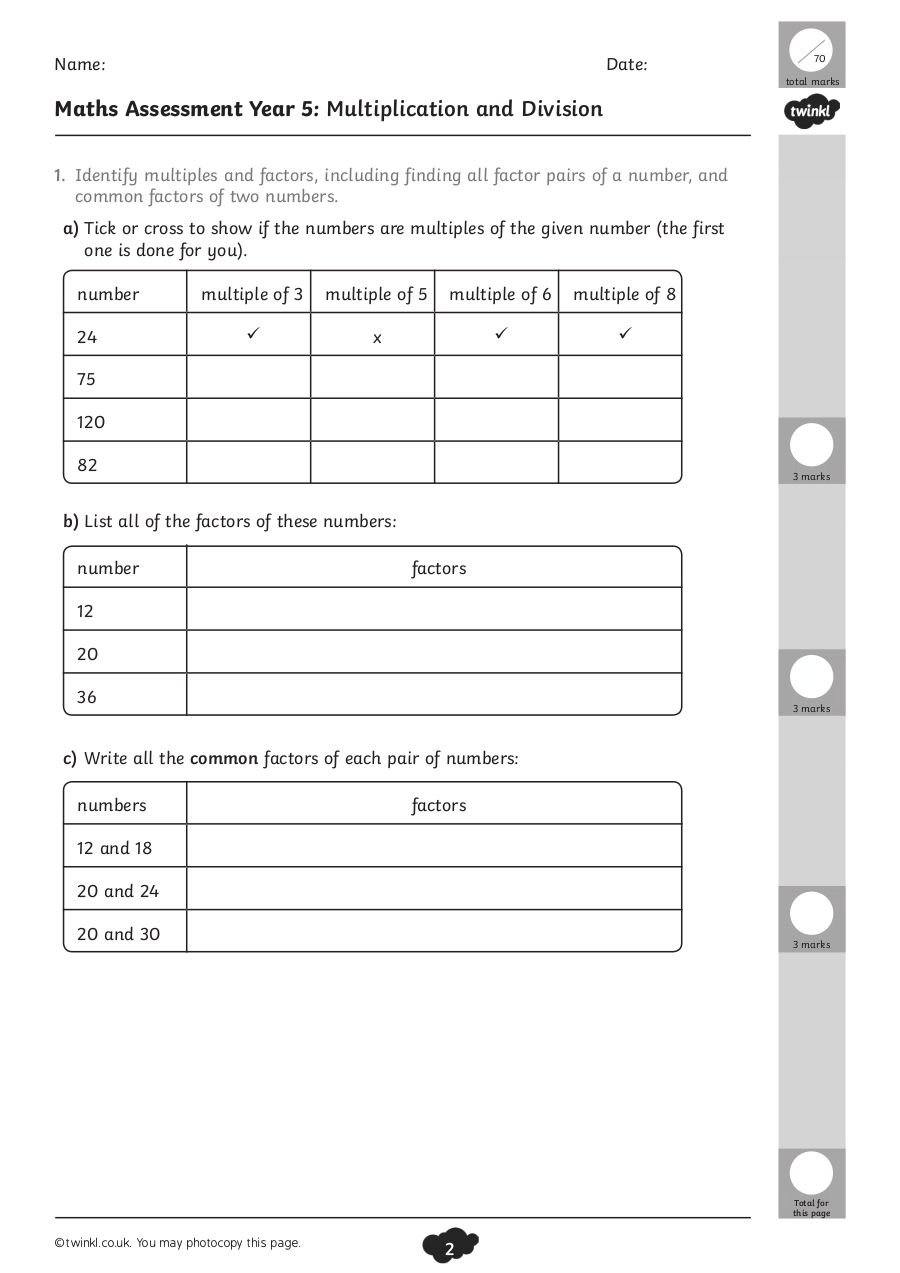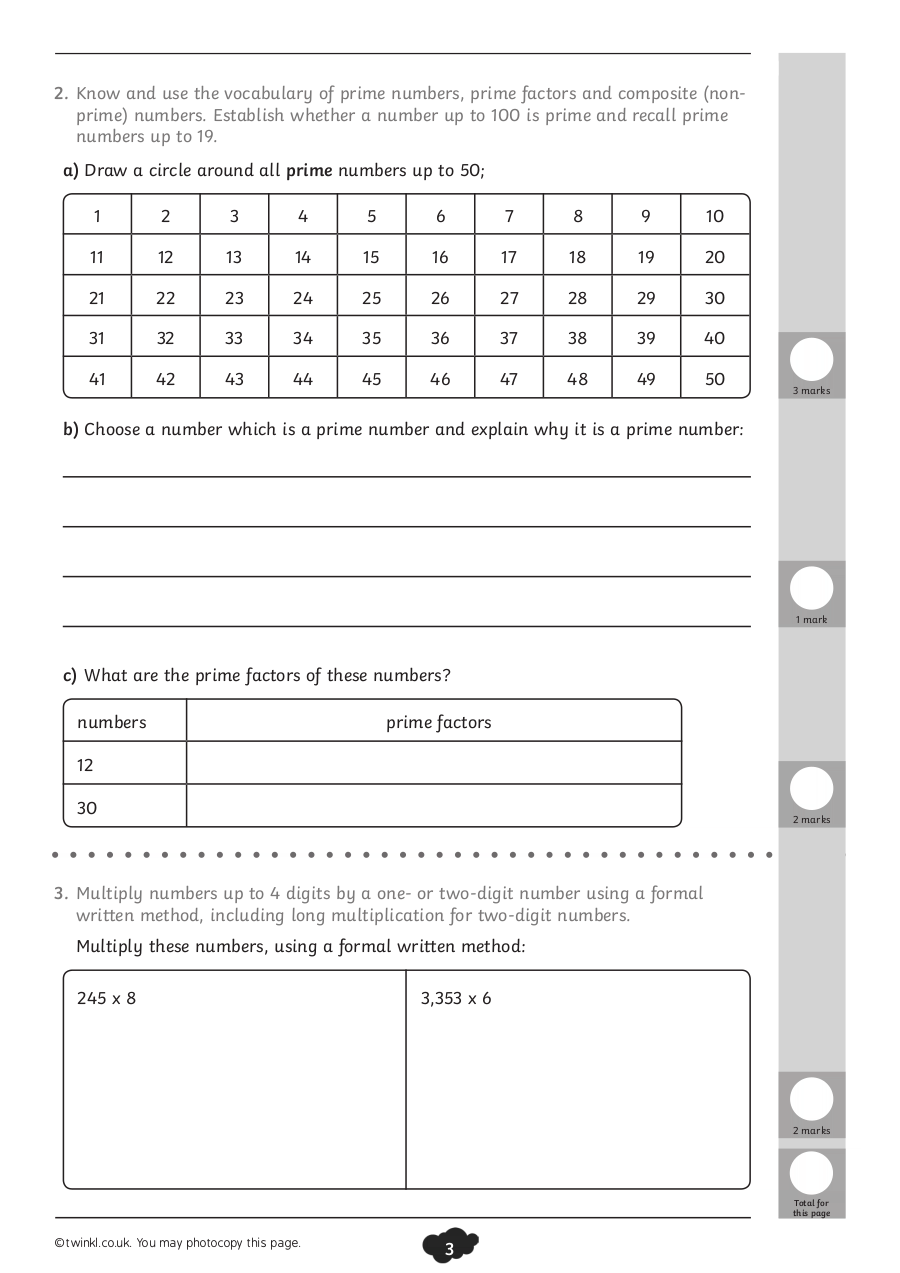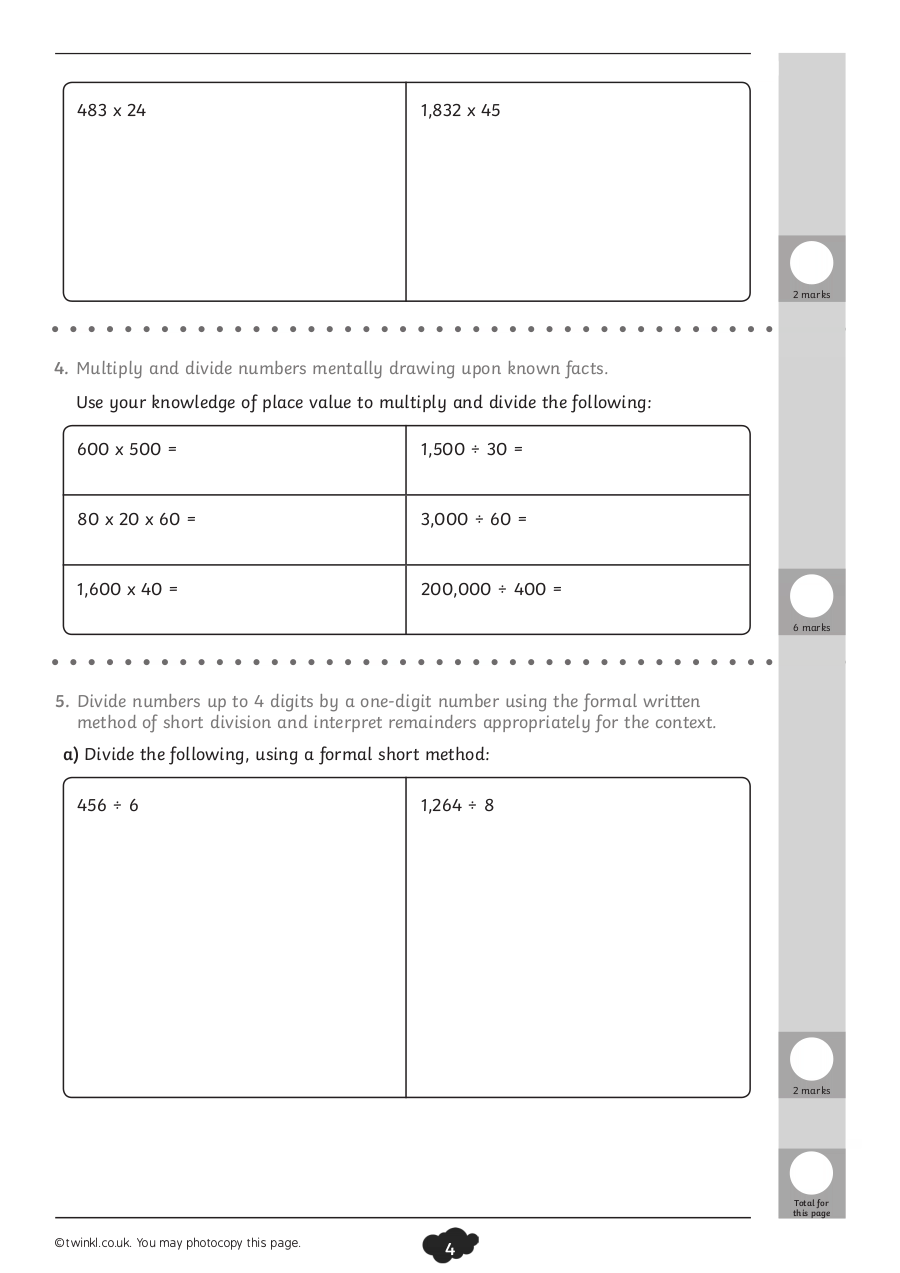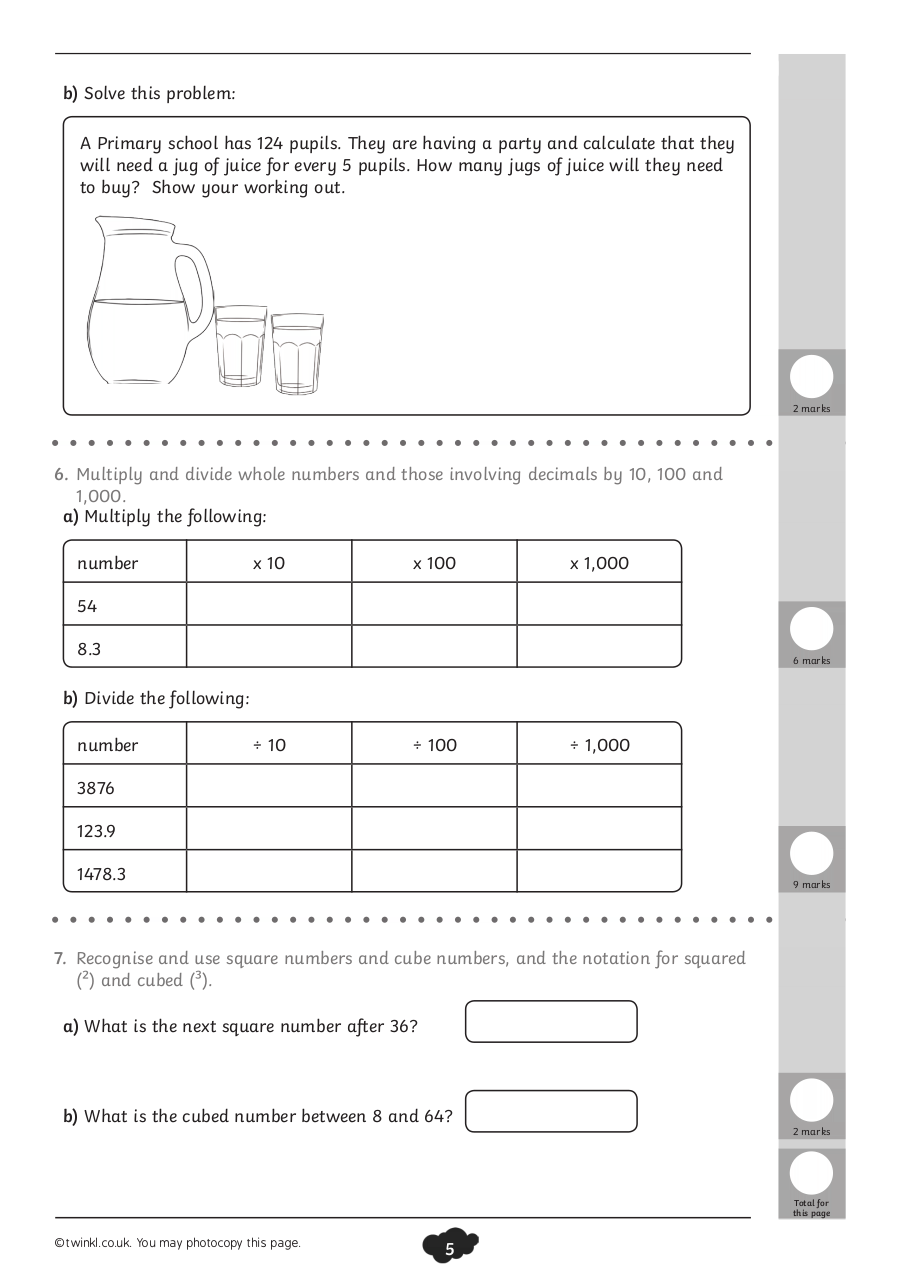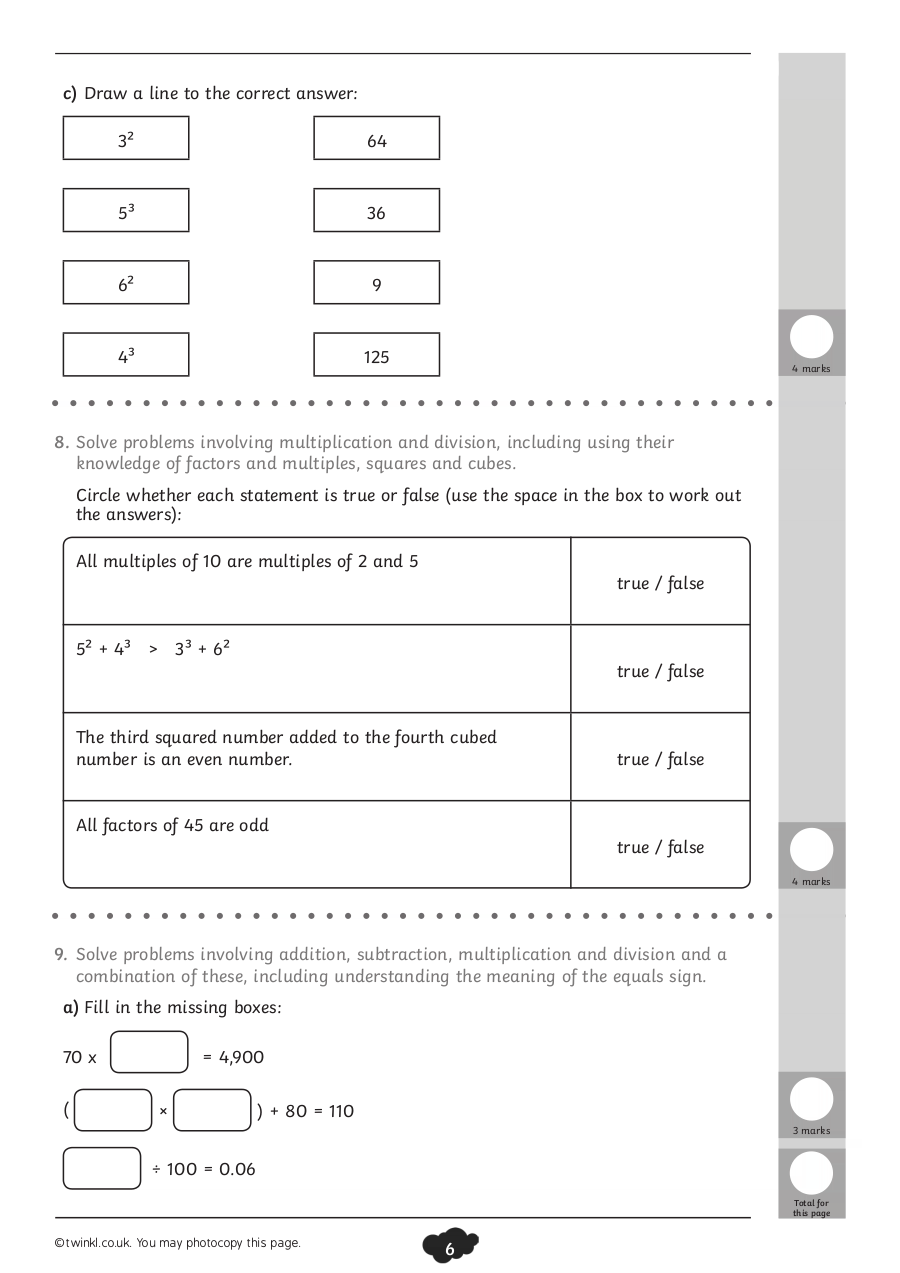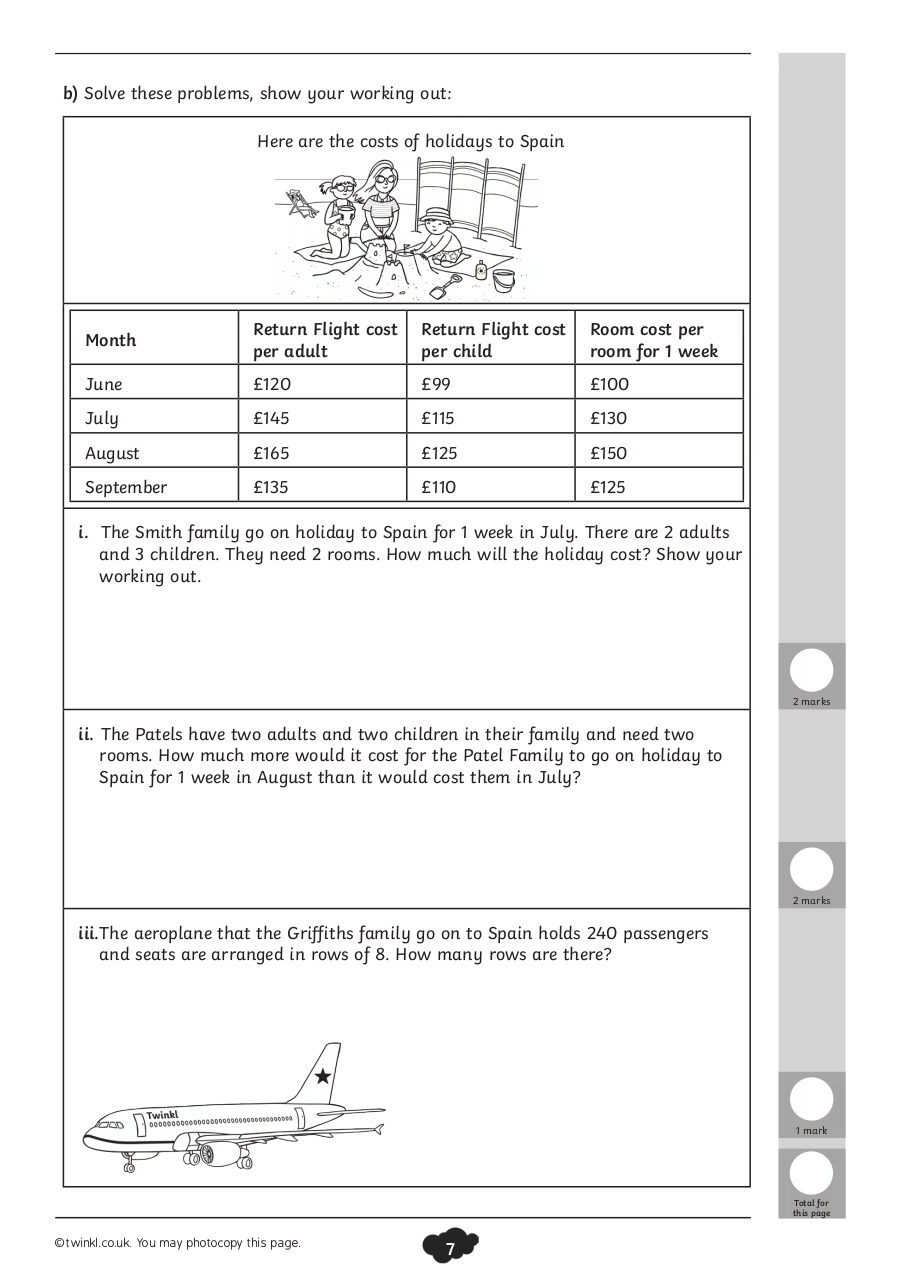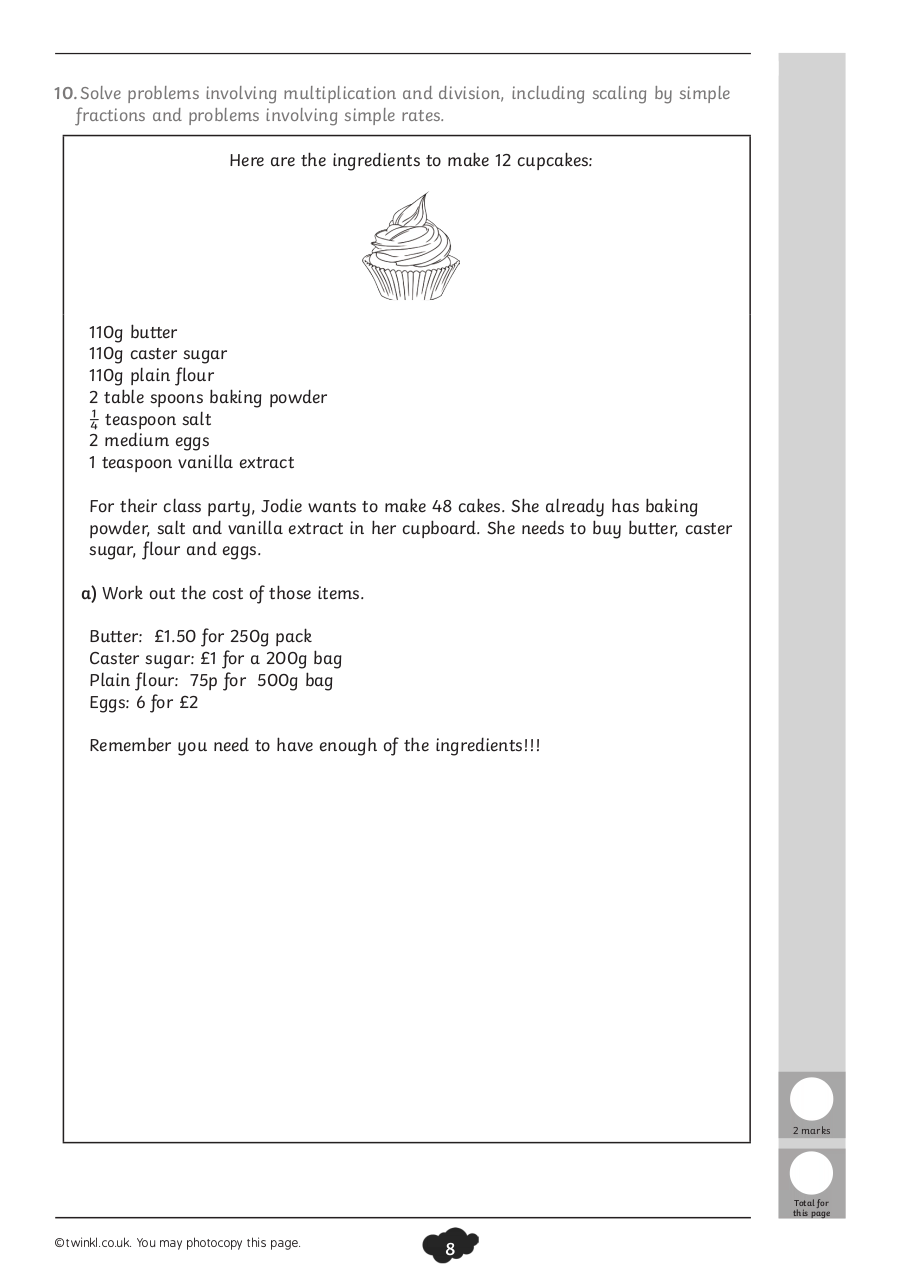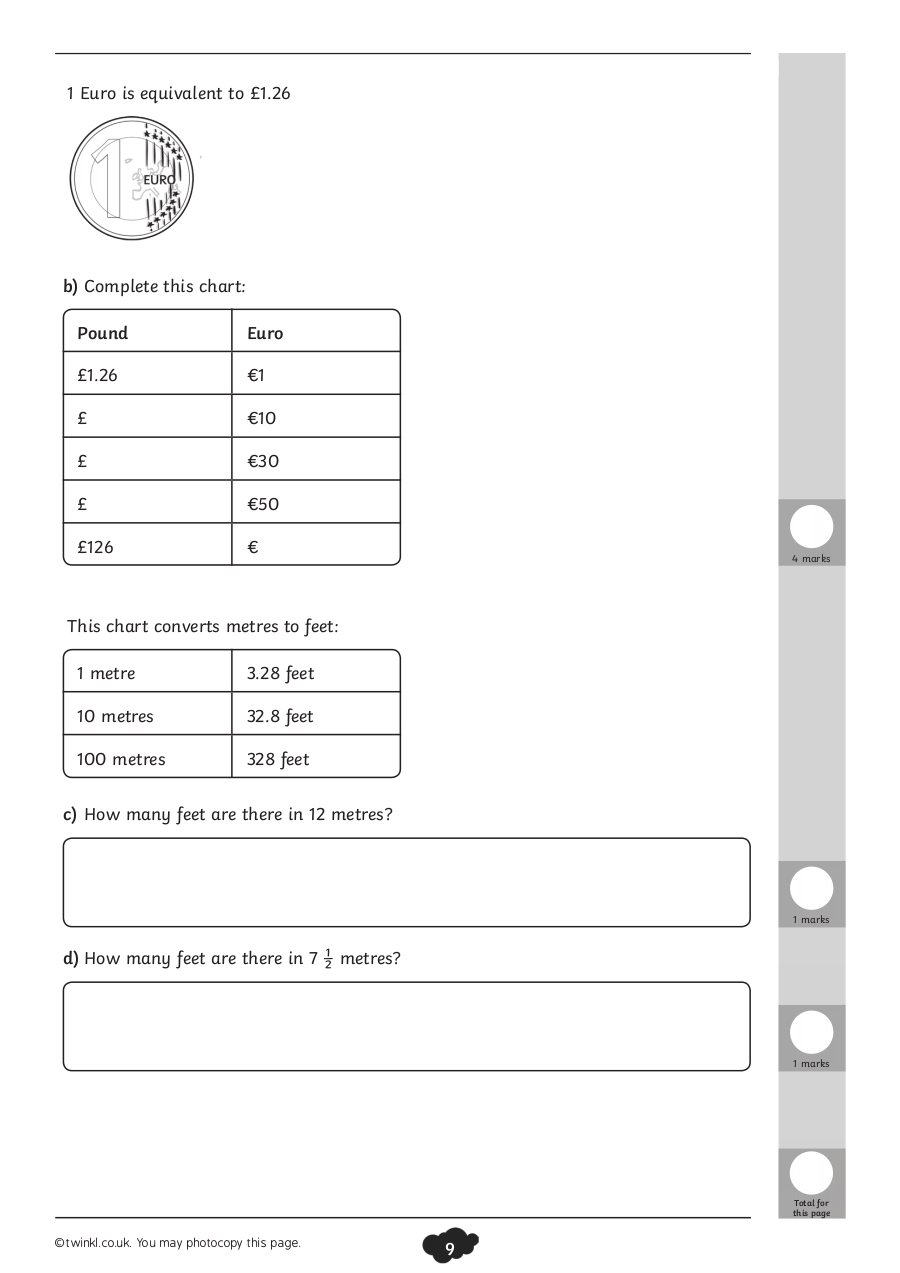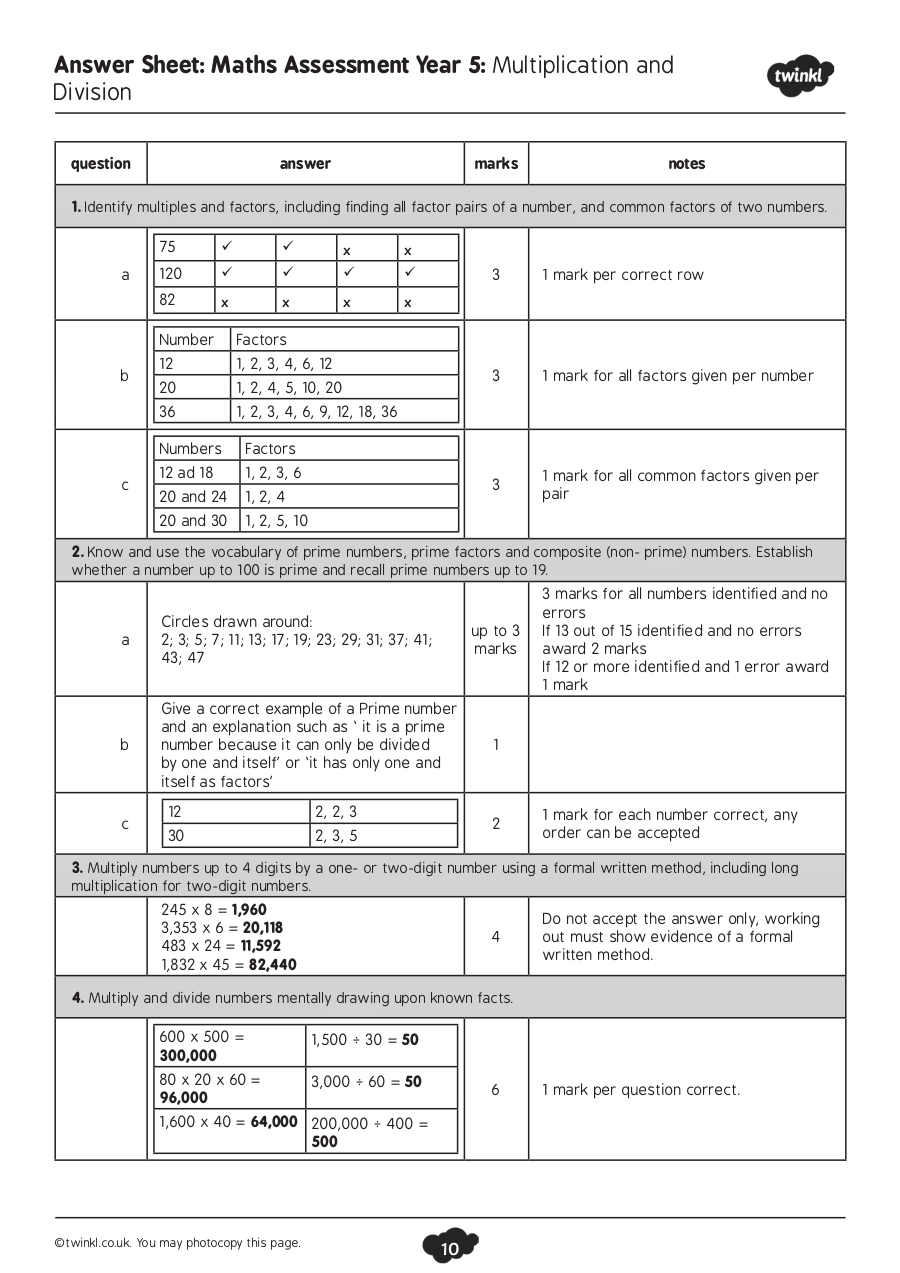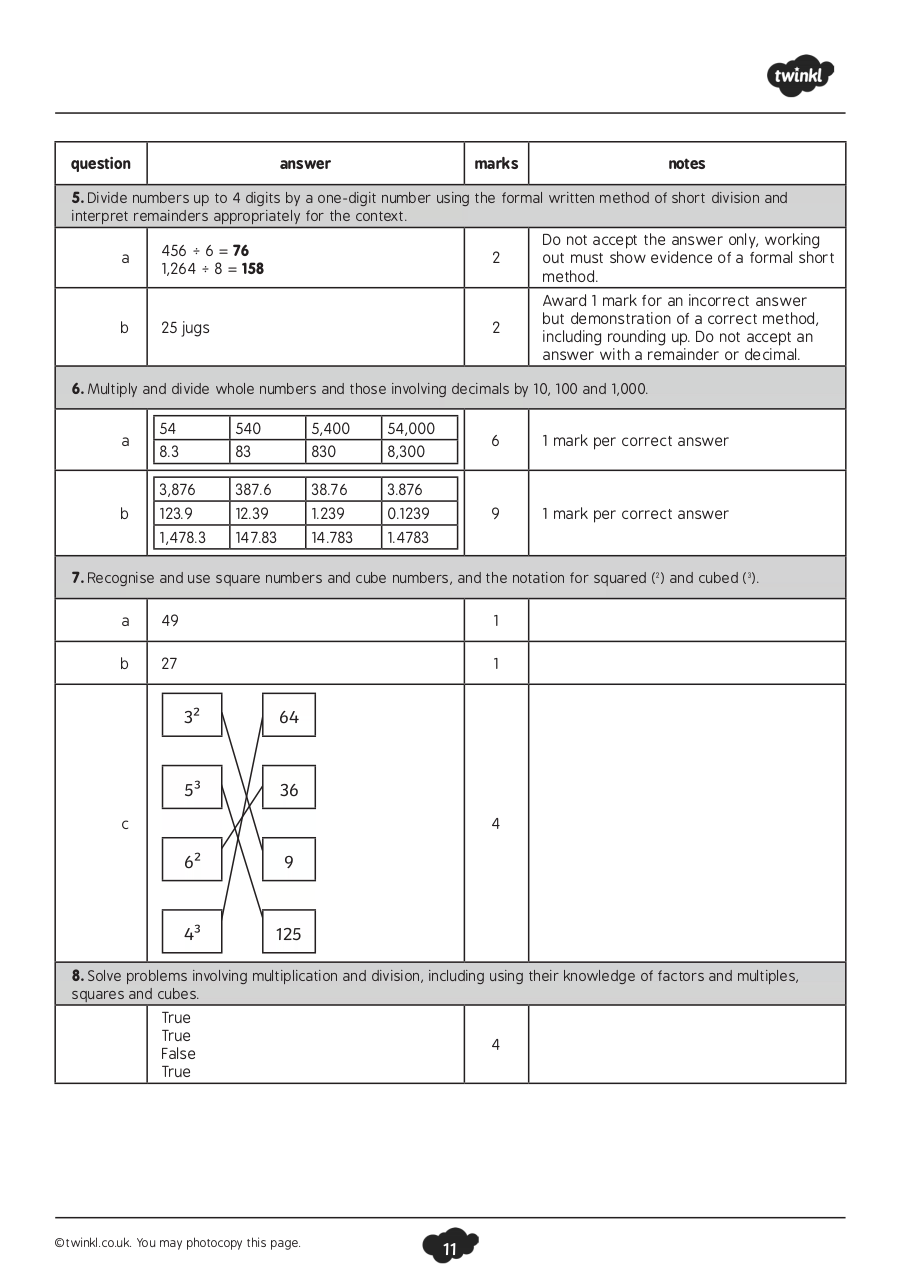Contributed by:
Y5 Multiplication and Division Asessment
1.
Maths Assessment Year 5: Multiplication and Division
1. Identify multiples and factors, including finding all factor pairs of a number, and common
factors of two numbers.
2. Know and use the vocabulary of prime numbers, prime factors and composite (non- prime)
numbers. Establish whether a number up to 100 is prime and recall prime numbers up to 19.
3. Multiply numbers up to 4 digits by a one- or two-digit number using a formal written
method, including long multiplication for two-digit numbers.
4. Multiply and divide numbers mentally drawing upon known facts.
5. Divide numbers up to 4 digits by a one-digit number using the formal written method of
short division and interpret remainders appropriately for the context.
6. Multiply and divide whole numbers and those involving decimals by 10, 100 and 1,000.
7. Recognise and use square numbers and cube numbers, and the notation for squared (²) and
cubed (³).
8. Solve problems involving multiplication and division, including using their knowledge of
factors and multiples, squares and cubes.
9. Solve problems involving addition, subtraction, multiplication and division and a combination
of these, including understanding the meaning of the equals sign.
10.Solve problems involving multiplication and division, including scaling by simple fractions
and problems involving simple rates.
©twinkl.co.uk. You may photocopy this page.
1
2.
70
Name: Date:
total marks
Maths Assessment Year 5: Multiplication and Division
1. Identify multiples and factors, including finding all factor pairs of a number, and
common factors of two numbers.
a) Tick or cross to show if the numbers are multiples of the given number (the first
one is done for you).
number multiple of 3 multiple of 5 multiple of 6 multiple of 8
24 x
75
120
82 3 marks
b) List all of the factors of these numbers:
number factors
12
20
36 3 marks
c) Write all the common factors of each pair of numbers:
numbers factors
12 and 18
20 and 24
20 and 30 3 marks
Total for
this page
©twinkl.co.uk. You may photocopy this page.
2
3.
2. Know and use the vocabulary of prime numbers, prime factors and composite (non-
prime) numbers. Establish whether a number up to 100 is prime and recall prime
numbers up to 19.
a) Draw a circle around all prime numbers up to 50;
1 2 3 4 5 6 7 8 9 10
11 12 13 14 15 16 17 18 19 20
21 22 23 24 25 26 27 28 29 30
31 32 33 34 35 36 37 38 39 40
41 42 43 44 45 46 47 48 49 50
3 marks
b) Choose a number which is a prime number and explain why it is a prime number:
1 mark
c) What are the prime factors of these numbers?
numbers prime factors
12
30
2 marks
3. Multiply numbers up to 4 digits by a one- or two-digit number using a formal
written method, including long multiplication for two-digit numbers.
Multiply these numbers, using a formal written method:
245 x 8 3,353 x 6
2 marks
Total for
this page
©twinkl.co.uk. You may photocopy this page.
3
4.
483 x 24 1,832 x 45
2 marks
4. Multiply and divide numbers mentally drawing upon known facts.
Use your knowledge of place value to multiply and divide the following:
600 x 500 = 1,500 ÷ 30 =
80 x 20 x 60 = 3,000 ÷ 60 =
1,600 x 40 = 200,000 ÷ 400 =
6 marks
5. Divide numbers up to 4 digits by a one-digit number using the formal written
method of short division and interpret remainders appropriately for the context.
a) Divide the following, using a formal short method:
456 ÷ 6 1,264 ÷ 8
2 marks
Total for
this page
©twinkl.co.uk. You may photocopy this page.
4
5.
b) Solve this problem:
A Primary school has 124 pupils. They are having a party and calculate that they
will need a jug of juice for every 5 pupils. How many jugs of juice will they need
to buy? Show your working out.
2 marks
6. Multiply and divide whole numbers and those involving decimals by 10, 100 and
1,000.
a) Multiply the following:
number x 10 x 100 x 1,000
54
8.3 6 marks
b) Divide the following:
number ÷ 10 ÷ 100 ÷ 1,000
3876
123.9
1478.3 9 marks
7. Recognise and use square numbers and cube numbers, and the notation for squared
(²) and cubed (³).
a) What is the next square number after 36?
b) What is the cubed number between 8 and 64?
2 marks
Total for
this page
©twinkl.co.uk. You may photocopy this page.
5
6.
c) Draw a line to the correct answer:
3² 64
5³ 36
6² 9
4³ 125 4 marks
8. Solve problems involving multiplication and division, including using their
knowledge of factors and multiples, squares and cubes.
Circle whether each statement is true or false (use the space in the box to work out
the answers):
All multiples of 10 are multiples of 2 and 5
true / false
5² + 4³ > 3³ + 6²
true / false
The third squared number added to the fourth cubed
number is an even number. true / false
All factors of 45 are odd
true / false
4 marks
9. Solve problems involving addition, subtraction, multiplication and division and a
combination of these, including understanding the meaning of the equals sign.
a) Fill in the missing boxes:
70 x = 4,900
( × ) + 80 = 110
3 marks
÷ 100 = 0.06
Total for
this page
©twinkl.co.uk. You may photocopy this page.
6
7.
b) Solve these problems, show your working out:
Here are the costs of holidays to Spain
Return Flight cost Return Flight cost Room cost per
Month
per adult per child room for 1 week
June £120 £99 £100
July £145 £115 £130
August £165 £125 £150
September £135 £110 £125
i. The Smith family go on holiday to Spain for 1 week in July. There are 2 adults
and 3 children. They need 2 rooms. How much will the holiday cost? Show your
working out.
2 marks
ii. The Patels have two adults and two children in their family and need two
rooms. How much more would it cost for the Patel Family to go on holiday to
Spain for 1 week in August than it would cost them in July?
2 marks
iii.The aeroplane that the Griffiths family go on to Spain holds 240 passengers
and seats are arranged in rows of 8. How many rows are there?
1 mark
Total for
this page
©twinkl.co.uk. You may photocopy this page.
7
8.
10. Solve problems involving multiplication and division, including scaling by simple
fractions and problems involving simple rates.
Here are the ingredients to make 12 cupcakes:
110g butter
110g caster sugar
110g plain flour
2 table spoons baking powder
¼ teaspoon salt
2 medium eggs
1 teaspoon vanilla extract
For their class party, Jodie wants to make 48 cakes. She already has baking
powder, salt and vanilla extract in her cupboard. She needs to buy butter, caster
sugar, flour and eggs.
a) Work out the cost of those items.
Butter: £1.50 for 250g pack
Caster sugar: £1 for a 200g bag
Plain flour: 75p for 500g bag
Eggs: 6 for £2
Remember you need to have enough of the ingredients!!!
2 marks
Total for
this page
©twinkl.co.uk. You may photocopy this page.
8
9.
1 Euro is equivalent to £1.26
b) Complete this chart:
Pound Euro
£1.26 €1
£ €10
£ €30
£ €50
£126 € 4 marks
This chart converts metres to feet:
1 metre 3.28 feet
10 metres 32.8 feet
100 metres 328 feet
c) How many feet are there in 12 metres?
1 marks
d) How many feet are there in 7 ½ metres?
1 marks
Total for
this page
©twinkl.co.uk. You may photocopy this page.
9
10.
Answer Sheet: Maths Assessment Year 5: Multiplication and
question answer marks notes
1. Identify multiples and factors, including finding all factor pairs of a number, and common factors of two numbers.
75 x x
a 120 3 1 mark per correct row
82 x x x x
Number Factors
12 1, 2, 3, 4, 6, 12
b 3 1 mark for all factors given per number
20 1, 2, 4, 5, 10, 20
36 1, 2, 3, 4, 6, 9, 12, 18, 36
Numbers Factors
12 ad 18 1, 2, 3, 6 1 mark for all common factors given per
c 3
20 and 24 1, 2, 4 pair
20 and 30 1, 2, 5, 10
2. Know and use the vocabulary of prime numbers, prime factors and composite (non- prime) numbers. Establish
whether a number up to 100 is prime and recall prime numbers up to 19.
3 marks for all numbers identified and no
errors
Circles drawn around:
up to 3 If 13 out of 15 identified and no errors
a 2; 3; 5; 7; 11; 13; 17; 19; 23; 29; 31; 37; 41;
marks award 2 marks
43; 47
If 12 or more identified and 1 error award
1 mark
Give a correct example of a Prime number
and an explanation such as ‘ it is a prime
b number because it can only be divided 1
by one and itself’ or ‘it has only one and
itself as factors’
12 2, 2, 3 1 mark for each number correct, any
c 2
30 2, 3, 5 order can be accepted
3. Multiply numbers up to 4 digits by a one- or two-digit number using a formal written method, including long
multiplication for two-digit numbers.
245 x 8 = 1,960
Do not accept the answer only, working
3,353 x 6 = 20,118
4 out must show evidence of a formal
483 x 24 = 11,592
written method.
1,832 x 45 = 82,440
4. Multiply and divide numbers mentally drawing upon known facts.
600 x 500 = 1,500 ÷ 30 = 50
300,000
80 x 20 x 60 = 3,000 ÷ 60 = 50
6 1 mark per question correct.
96,000
1,600 x 40 = 64,000 200,000 ÷ 400 =
500
©twinkl.co.uk. You may photocopy this page.
10
11.
question answer marks notes
5. Divide numbers up to 4 digits by a one-digit number using the formal written method of short division and
interpret remainders appropriately for the context.
Do not accept the answer only, working
456 ÷ 6 = 76
a 2 out must show evidence of a formal short
1,264 ÷ 8 = 158
method.
Award 1 mark for an incorrect answer
but demonstration of a correct method,
b 25 jugs 2
including rounding up. Do not accept an
answer with a remainder or decimal.
6. Multiply and divide whole numbers and those involving decimals by 10, 100 and 1,000.
54 540 5,400 54,000
a 6 1 mark per correct answer
8.3 83 830 8,300
3,876 387.6 38.76 3.876
b 123.9 12.39 1.239 0.1239 9 1 mark per correct answer
1,478.3 147.83 14.783 1.4783
7. Recognise and use square numbers and cube numbers, and the notation for squared (²) and cubed (³).
a 49 1
b 27 1
3² 64
5³ 36
c 4
6² 9
4³ 125
8. Solve problems involving multiplication and division, including using their knowledge of factors and multiples,
squares and cubes.
True
True
4
False
True
©twinkl.co.uk. You may photocopy this page.
11
12.
question answer marks notes
9. Solve problems involving addition, subtraction, multiplication and division and a combination of these, including
understanding the meaning of the equals sign.
70 x 70 = 4900
a (6 x 5) + 80 = 110 or (3x10) or (2x15) 3 1 mark per correct answer
6 ÷ 100 = 0.06
bi £895 2
Award 1 mark for an incorrect answer but
demonstration of a correct method.
b ii £100 2
b iii 30 1
10. Solve problems involving multiplication and division, including scaling by simple fractions and problems involving
simple rates.
Award 1 mark for an incorrect answer but
a £10.75 2
demonstration of a correct method.
£1.26 €1
£12.6(0) €10 Accept £12.6 or £12.60
b £37.8(0) €30 4
£63 €50 Accept £37.8 or £37.80
£126 €100
c 39.36 feet 1
Accept without feet
d 24.6 feet 1
Total
70
©twinkl.co.uk. You may photocopy this page.
12

